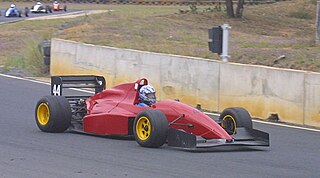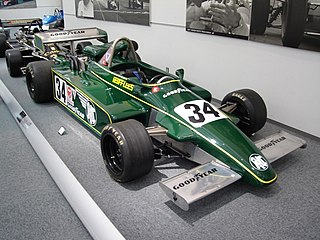Related Research Articles

The Formula 3000 International Championship was a motor racing series created by the Fédération Internationale de l'Automobile (FIA) in 1985 to become the final preparatory step for drivers hoping to enter Formula One. Formula Two had become too expensive, and was dominated by works-run cars with factory engines; the hope was that Formula 3000 would offer quicker, cheaper, more open racing. The series began as an open specification, then tyres were standardized from 1986 onwards, followed by engines and chassis in 1996. The series ran annually until 2004, and was replaced in 2005 by the GP2 Series.

Formula Two is a type of open-wheel formula racing category first codified in 1948. It was replaced in 1985 by Formula 3000, but revived by the FIA from 2009–2012 in the form of the FIA Formula Two Championship. The name returned again in 2017 when the former GP2 Series became known as the FIA Formula 2 Championship.

Formula Three, also called Formula 3, abbreviated as F3, is a third-tier class of open-wheel formula racing. The various championships held in Europe, Australia, South America and Asia form an important step for many prospective Formula One drivers.
Lola Cars Limited is a British automobile manufacturer founded in 1958 by Eric Broadley in Bromley, England. The company is now owned by Till Bechtolsheimer, which he purchased in 2022. Lola Cars endured for more than fifty years to become one of the oldest and largest manufacturers of racing cars in the world. Lola started by building small front-engine sports cars, and branched out into Formula Junior cars before diversifying into a wider range of sporting vehicles. In 2012, Lola Cars stopped operations. Lola is set to make a return to motorsport in 2024 by joining the Formula E World Championship as a powertrain supplier in a technical partnership with Yamaha with Abt as their customer.

Dallara Group S.r.l. is the largest multi-national Italian race car manufacturer, founded by its current President, Giampaolo Dallara. After working for Ferrari, Maserati, Lamborghini and De Tomaso, in 1972 in his native village of Varano de' Melegari (Parma), he created Dallara Automobili.
March Engineering was a Formula One constructor and manufacturer of customer racing cars from the United Kingdom. Although only moderately successful in Grand Prix competition, March racing cars enjoyed much better success in other categories of competition, including Formula Two, Formula Three, IndyCar and IMSA GTP sportscar racing.

Formula Holden was an Australian open wheel racing category introduced in 1989.

Formula Atlantic is a specification of open-wheel racing car developed in the 1970s. It was used in professional racing through the IMSA Atlantic Championship until 2009 and is currently primarily used in amateur racing through Sports Car Club of America Formula Atlantic.

Judd is a brand of racing car engines built by Engine Developments Ltd., a company founded in 1971 by John Judd and Jack Brabham in Rugby, Warwickshire, England. Engine Developments was intended to build engines for Brabham's racing efforts, and became one of the first firms authorised by Cosworth to maintain and rebuild its DFV engines, but has since expanded into various areas of motorsport.

Ralt was a manufacturer of single-seater racing cars, founded by ex-Jack Brabham associate Ron Tauranac after he sold out his interest in Brabham to Bernie Ecclestone. Ron and his brother had built some specials in Australia in the 1950s under the Ralt name. Tauranac won the 1954 NSW Hillclimb Championship in the Ralt 500.
Gould Racing is a British motorsport company, specialising in racing car manufacture and engineering. The company is run by David Gould, and is based in Newbury, Berkshire, England.
The Matich name was applied to a series of sports racing cars and open wheel racing cars produced in Australia between 1967 and 1974 under the direction of Sydney-based racing driver and engineer Frank Matich.

The Ralt RT1 is a race car chassis produced by Ralt, and was the first modern car produced by the company. It saw widespread use in a number of different motorsports categories, mostly open-wheel racing, but later including sports car racing. It was powered by a number of different four-cylinder engines of about 1.6 L (98 cu in) in displacement, of different origin, including Hart, Cosworth, Toyota, and Volkswagen engines.

The Ralt RT3 is an open-wheel Formula 3 race car, developed and built by Ralt in 1979.
The 1985 British Formula Three Championship was the 35th season of the British Formula Three Championship. Maurício Gugelmin took the BARC/BRDC Marlboro British Formula 3 Championship.
The Swift DB4 is an open-wheel formula racing car chassis, designed, developed and built by American Company Swift Engineering, for the Formula Atlantic spec-series, between 1987 and 1997. It won the championship five times, with four championships won four consecutive years in a row. It was powered by naturally aspirated 1.6 L (98 cu in) Toyota 4A-GE four-cylinder engine, producing about 240 hp (180 kW), which drove the rear wheels through a standard 5-speed manual transmission.

The Ralt RH6 is an open-wheel formula racing car chassis, designed, developed and built by Australian constructor and manufacturer Ralt, for Formula Two racing categories, in 1980. It saw continued use in motor racing through 1984.
The Lola T850 is an open-wheel Formula 2 racing car from the British manufacturer Lola Cars, which was used in the European and Japanese Formula 2 Championships in the early 1980s. It is not Lola's own construction, but a car produced under a license that was developed by competing companies. A variant of the Lola T850 is the Docking Spitzley DS1. Lola also built a version destined for Formula Atlantic, sold as the Toleman TA860.
The Alpine A330 was an open-wheel Formula 3 race car, designed, developed and built by French racing team and constructor Renault Alpine in 1967, and competed in motor racing between 1968 and 1969.
The Cooper T83 is an open-wheel formula racing car, designed, developed and built by British manufacturer Cooper, for Formula 3 categories, in 1966. It was an evolution of the previous T76. It was powered by a 998 cc (60.9 cu in) BMC four-cylinder engine, developing 88 hp (66 kW) @ 7,750 rpm, which had a 12.5:1 compression ratio. The chassis used was a tubular space frame, while the body was constructed as a semi-stressed skin. The front suspension was altered to widen the front track and minimise the leverage rate of the front shock absorbers. The rear suspension was also totally reworked, to equal the symmetry of the T81 Formula One car. The car was not successful. It suffered severe understeer, due to the undertray of the car being "flat-bottomed" in design, almost creating aerodynamic vortices under the car, and affecting its ground effect properties. Only 7 models were produced. A developmental version of the car used a larger Cosworth SCB Formula Two engine. It entered more than 5 races, and claimed one pole position, but didn't finish that particular race; with the wheel coming off, and achieved no further success after that.
References
- ↑ "RALT RACING HISTORY". May 10, 2013. Archived from the original on 2013-05-10.
- ↑ "RALT RACING HISTORY".
- ↑ "Ralt – F3History". www.f3history.co.uk.
- ↑ "Ralt RT 33-VW" . Retrieved 16 June 2022.